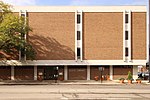Fire Museum of Greater Cincinnati
AC with 0 elementsCincinnati Local Historic LandmarksFirefighting museums in the United StatesHamilton County, Ohio Registered Historic Place stubsHistory museums in Ohio ... and 3 more
Museums in CincinnatiNational Register of Historic Places in Hamilton County, OhioOhio museum stubs

The Fire Museum of Greater Cincinnati, also known as the Cincinnati Fire Museum, preserves and exhibits Greater Cincinnati, Ohio's firefighting artifacts and honors firefighters, both past and present. Over 200 years of firefighting history is on display in the Fire Museum of Greater Cincinnati. Exhibits include examples of early leather fire buckets, an 1808 fire drum, the oldest surviving fire engine in Cincinnati, and an 1836 hand pumper. The museum also features and interactive exhibit that allows visitors to experience a modern Emergency-One fire engine cab by wailing the siren, ringing the bell, and flashing the lights.
Excerpt from the Wikipedia article Fire Museum of Greater Cincinnati (License: CC BY-SA 3.0, Authors, Images).Fire Museum of Greater Cincinnati
Lloyd Alley, Cincinnati West End
Geographical coordinates (GPS) Address Nearby Places Show on map
Geographical coordinates (GPS)
| Latitude | Longitude |
|---|---|
| N 39.105277777778 ° | E -84.519444444444 ° |
Address
Lloyd Alley
Lloyd Alley
45203 Cincinnati, West End
Ohio, United States
Open on Google Maps










